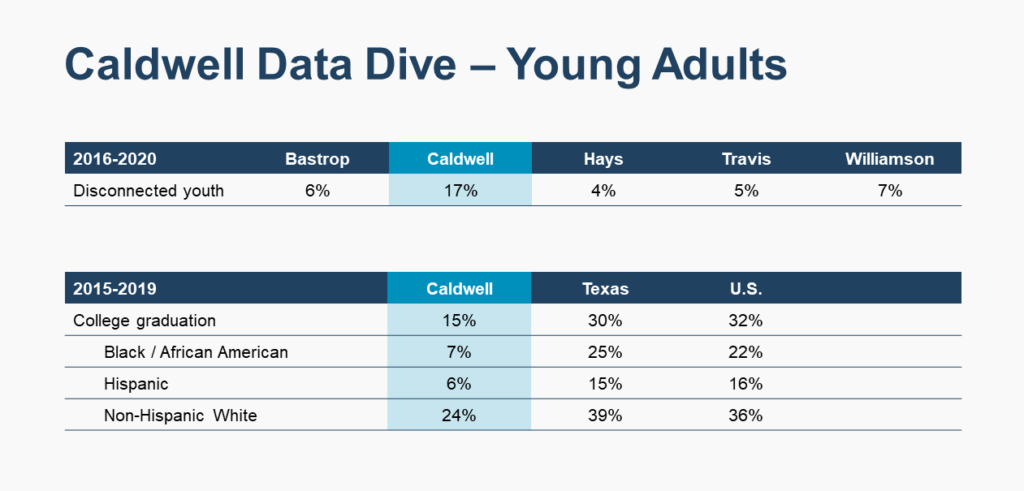Takeaway
The Issue
From 2010-2019, Caldwell County’s population grew 12.6%. During that ten-year period, Hispanic/Latinx residents accounted for the largest ethnic or racial group in the county and experienced the largest growth of all racial and ethnic groups for that time, going from 47.1% to 55%. In the county, 11.1% of people were born somewhere other than the U.S., 8% of people are not U.S. citizens, and 35% of households primarily speak Spanish, creating challenges to receiving health care services that culturally and linguistically meet the needs of Caldwell community members.
Focus group participants noted that with the increase of people moving to Caldwell County, cost of living and property prices have become increasingly unaffordable to long-time residents, especially Black/African American and Hispanic/Latinx community members. The average home price in the county increased 7.1% in 2020 and 29.3% in 2021 with 14% of households spending more than 50% of their income on housing. Housing instability is increasing the risk for foreclosure and eviction compared to January 2020, exacerbating financial stress and impacting mental and physical health for many families.
Furthermore, Caldwell County has areas of concentrated poverty and households that live above the federal poverty line but earn less than the basic costs of living for the county. The county’s median household income is lower than all other Austin-Round Rock metropolitan counties as well as the U.S. as a whole, and in 2019 Black/African American and Hispanic/Latinx households had the lowest median income. With 15% of people in the county living below the federal poverty level, Black/African American and Hispanic/Latinx are the most likely to live below the poverty level (49.1% of Black/African American and 22% of Hispanic/Latinx).
However, with the high costs of living, increased housing costs, food insecurity, transportation barriers, and racism and discrimination, many community members are experiencing barriers to health care and healthy lifestyles. The cost of care, insurance coverage, provider availability, cultural barriers, and lack of transportation make access to health care difficult. Almost 19% of Caldwell County adults have not sought care due to costs and 28.2% of adults have reported having no common source of health care. Nearly 22% of the population under 65 years old is uninsured. The county has been designated a primary health professional shortage area and a mental health professional shortage area. Despite the increase in primarily Spanish-speaking households, community focus group participants identified that there is an insufficient number of Spanish-speaking providers or providers with appropriate translation services. There is also a need for providers and services that are more informed and accommodating in serving racial and ethnic minorities. The lack of a public transportation infrastructure also inhibits people’s ability to access services and ultimately the ability to be healthy. On average, 24% of household income is spent on transportation costs.

Looking forward: Caldwell County has several community assets and strengths. The community has a history of resiliency as well as community members who have a genuine desire to help. Caldwell County is home to three Ascension Seton health care sites, one Federally Qualified Health Center and three National Health Service Corps sites. A strong network of churches from many denominations collaborate to meet community needs, distributing food and clothing and conducting home visits for struggling and isolated community members. Caldwell County’s strong nonprofit and community organizations play a vital role in building healthy communities through education, health, and social services. The county’s natural spaces provide opportunities for physical activity, time in nature, and connection through community events.
The Findings
Community members provided several recommendations to address health-related needs for the county which fell into three priority buckets: improve access to care, address barriers to overall health, and strengthen community trust.
Improve access to care by addressing the barriers that impede access to affordable and culturally appropriate care, offering mobile clinics in rural areas to eliminate transportation challenges, establishing an urgent care that offers after-hours and weekend emergency care, and improving and expanding access to mental health services.
Address barriers to overall health by establishing a recreation center that offers free or low-cost classes, workout equipment, and meeting spaces for community activities and physical fitness; expanding access to affordable and healthy food; making public spaces safer and more accessible to the entire county; and improving public transportation services with hospital-sponsored buses or vans to connect to community clinics.
Strengthen community trust by engaging with community-trusted grassroots organizations, involving local officials to participate in historically excluded communities, and expanding the culturally competent health care workforce.
Building on Caldwell County’s collaborative efforts, key community partners and health care groups can enhance the overall health of the community, ensuring trust is built, barriers removed, and access improved. Download the report below to learn more about the 2022 community health needs assessment findings for Caldwell County.